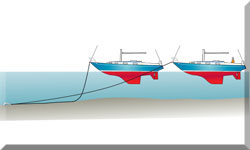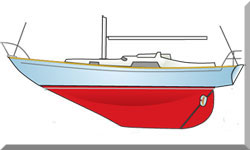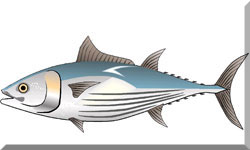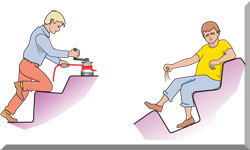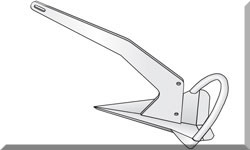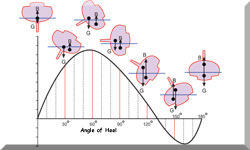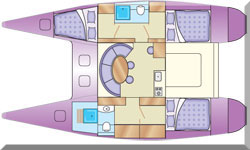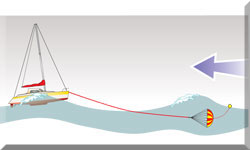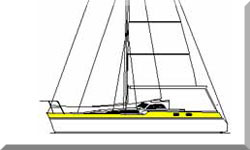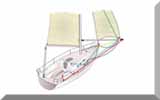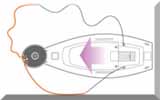- Home
- RM Sailboats
RM Yachts: A French Builder’s Unique Approach to Performance Cruising
In a Nutshell: Key Takeaways
RM Yachts, now part of the Grand Large Yachting group and originally founded in La Rochelle, France, is renowned for its performance-oriented cruising yachts built using a distinctive plywood-epoxy composite technique. Designed primarily by Marc Lombard, these sailboats feature an easily recognisable, modern, multi-chine hull shape and offer exceptional performance, especially off the wind. They are prized by experienced sailors for their strength-to-weight ratio, stiffness, impressive interior light and volume—particularly the 180-degree panoramic saloon view—and suitability for bluewater cruising. Key models like the RM 1050, RM 1260, and the later RM 1350/1380 have cemented the brand’s reputation for offering a fast, comfortable, and unique alternative to mass-produced fibreglass yachts.
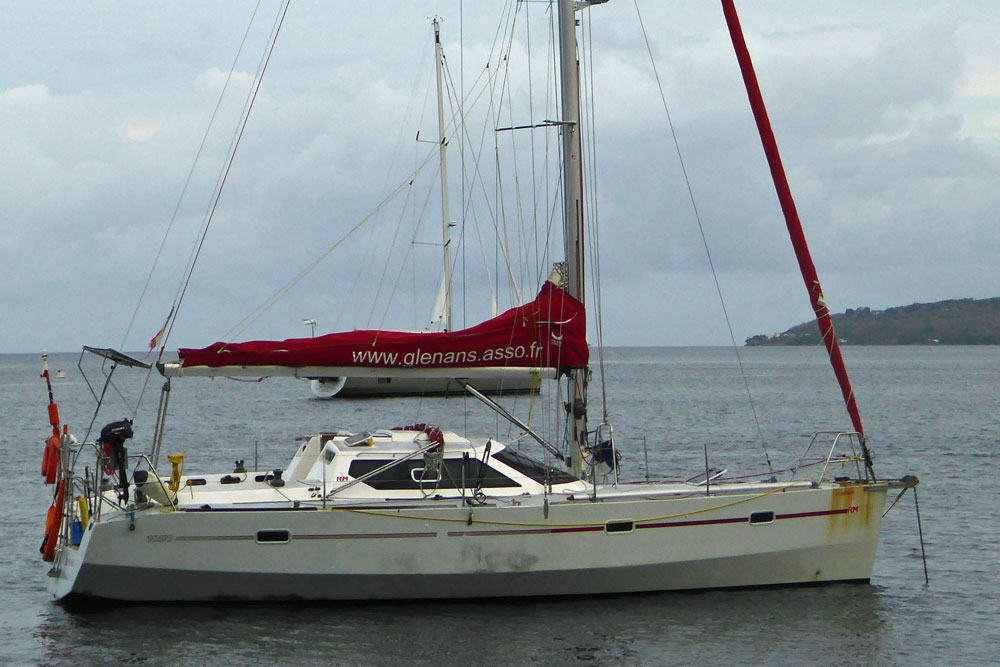 The RM1050 plywood/epoxy cruiser
The RM1050 plywood/epoxy cruiserTable of Contents
The elusive balance of speed, comfort, and seaworthiness is pursued by most modern boat builders but not always achieved. French yard RM Yachts, formerly Fora Marine, has achieved this balance by taking a path less travelled. Since its inception, the brand has distinguished itself with a design philosophy that marries ocean racing inspiration with pragmatic cruising demands, all wrapped up in a visually striking, modern package.
RM yachts are immediately recognisable on the water. They stand apart from the typical white-hulled crowd with their bold, often brightly coloured topsides and their characteristic hard-chine hull form—features that speak volumes about their performance DNA. The use of a plywood-epoxy construction—a method more commonly associated with custom or small-scale builders—is the foundation of their unique identity and their success in producing lightweight, stiff, and fast cruising boats. This article delves into the brand’s history, its innovative construction, and what makes an RM a compelling choice for the high-mileage, expert sailor.
RM kicked it all off with their landmark model, the 1050...
Company History & Pioneering Design Philosophy
Who founded RM Yachts and what is their mission?
RM Yachts was originally founded as Fora Marine in La Rochelle, France, in the 1980s by Martin Lepoutre. The company’s core mission was to create fast, comfortable, and durable cruising yachts that stood apart from the mass-market offerings. A critical decision early on was the collaboration with the renowned naval architect Marc Lombard, who has been the exclusive designer for the brand for over two decades. Lombard's influence, stemming from his expertise in high-performance and ocean-racing designs (such as the Figaro class), is evident in every RM model.
The yard’s initial success was built upon the philosophy that a cruising yacht could be both fast and incredibly comfortable. Their distinctive use of plywood-epoxy construction was not a nostalgic choice, but a calculated engineering decision to achieve an optimal strength-to-weight ratio—a vital factor in performance yacht design.
The company experienced financial difficulties, leading to insolvency proceedings in 2019. This was a challenging period for owners and those with yachts on order. However, the brand’s strong image and loyal following paved the way for its rescue and subsequent acquisition by the Grand Large Yachting (GLY) group. This conglomerate also owns respected bluewater brands like Allures, Garcia, and Outremer, ensuring RM’s survival and its continued commitment to high-quality, long-distance cruising yachts. Today, production remains in La Rochelle, focusing on small-series, quality builds.
Construction & Quality: The Plywood-Epoxy Advantage
Why are RM hulls built with plywood and epoxy?
The most defining characteristic of an RM yacht is its construction method: a sophisticated plywood-epoxy composite. This technique is central to achieving the brand’s design goals of lightweight performance and exceptional stiffness.
The hulls are built from high-quality, laser-cut marine-grade plywood (typically Okoumé) panels. These panels are assembled onto a structural jig, forming the distinctive multi-chine hull shape. The joints are then heavily glued using a high-strength, two-component epoxy resin. Crucially, every piece of plywood is sealed and coated with epoxy, making the structure impervious to water ingress and eliminating the risk of osmosis, a common concern with older fibreglass hulls. The internal structure, including the bulkheads, is also plywood-epoxy and is laminated directly to the hull, creating a monolithic, incredibly stiff structure.
For increased structural integrity and to handle the high loads from the rig and keel, a galvanised steel frame is often integrated into the hull structure. The deck, unlike the hull, is typically a fibreglass sandwich construction, usually applied using the vacuum infusion process for lightness and stiffness. Once the deck is fitted, it is laminated to the hull using epoxy, creating a single, fully watertight unit.
This unique composite construction offers several key benefits for the serious sailor:
- Light Displacement & Performance: Plywood-epoxy offers a superior strength-to-weight ratio compared to typical production fibreglass, enabling the RM yachts to be lighter and therefore faster.
- Insulation & Comfort: Wood provides natural insulation, resulting in a drier, warmer interior with minimal condensation, a significant benefit for liveaboard or long-term cruising in varying climates.
- Durability & Repairability: The laminated structure is highly durable, and in the event of damage, a plywood hull is often easier to repair in remote locations than a complex fibreglass sandwich—a significant consideration for bluewater cruising.
Design Evolution & Key Models
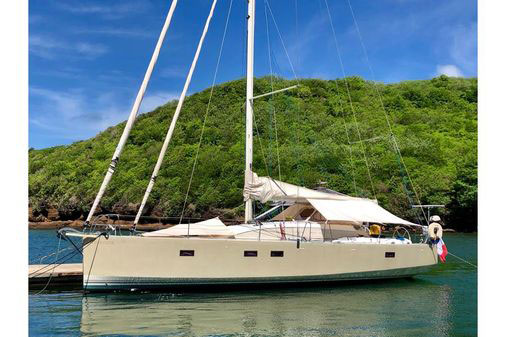 The RM1260 is a popular choice for serious offshore cruising couples.
The RM1260 is a popular choice for serious offshore cruising couples.Specs & performance indicators for the RM1260...
What are the most popular and successful RM sailboat models?
The RM line-up is defined by its constant evolution under Marc Lombard, with each model building on the success and performance of its predecessor. The designs are characterised by a broad beam carried well aft, a relatively shallow bilge, and a twin-rudder arrangement, all features borrowed from modern ocean racing yachts to maximise speed and stability.
| Model | Length (Approx.) | Key Feature & Significance |
|---|---|---|
| RM 1050 | 34.5 ft | Landmark model; European Yacht of the Year 2000 (France); firmly established the twin-keel, plywood-epoxy concept. |
| RM 1260 | 41 ft | Highly successful mid-range cruiser; won European Yacht of the Year (2012); a popular choice for serious offshore couples. |
| RM 1350 | 44.5 ft | Earlier large model (replaced by the 1380/1450); epitomised the fast, high-volume cruiser suitable for extended voyages. |
| RM 1180 | 39 ft | Modern successor, known for exceptional performance, winning Yacht of the Year 2020 (France). |
The most distinctive feature across the range is the option of twin keels (or bilge keels) alongside the standard deep-draught single keel. The twin-keel option allows the boat to stand upright on the tide—ideal for tidal areas like the French and UK coasts—and provides excellent stability while maintaining a respectable draught for offshore work.
Performance & Seaworthiness for the Expert Sailor
How does an RM perform for serious offshore sailing?
RM yachts are designed to be true performance cruisers, not mere coastal runabouts. Their hull shape—beamy aft with hard chines—offers significant form stability, reducing the degree of heel and increasing comfort and speed on all points of sail.
- Speed and Motion: With their light displacement, generous sail area, and efficient hull form, RMs are known for high average speeds and fast passage-making, particularly when reaching or running. Unlike some other fast cruisers, the motion is often praised as being smooth and predictable, vital for crew fatigue on long passages.
- Offshore Capability: The twin-rudder arrangement provides excellent control, even when the yacht is pressed hard or heavily loaded for a long voyage. The structural rigidity of the plywood-epoxy hull contributes significantly to its feeling of seaworthiness and durability in heavy weather.
- Sail Plan: The sail plans are powerful, typically featuring a large mainsail and a manageable headsail configuration, often with an inner forestay for a working jib, a must for offshore security. Their ability to carry a large asymmetric spinnaker or gennaker off the wind is a key component of their fast cruising appeal.
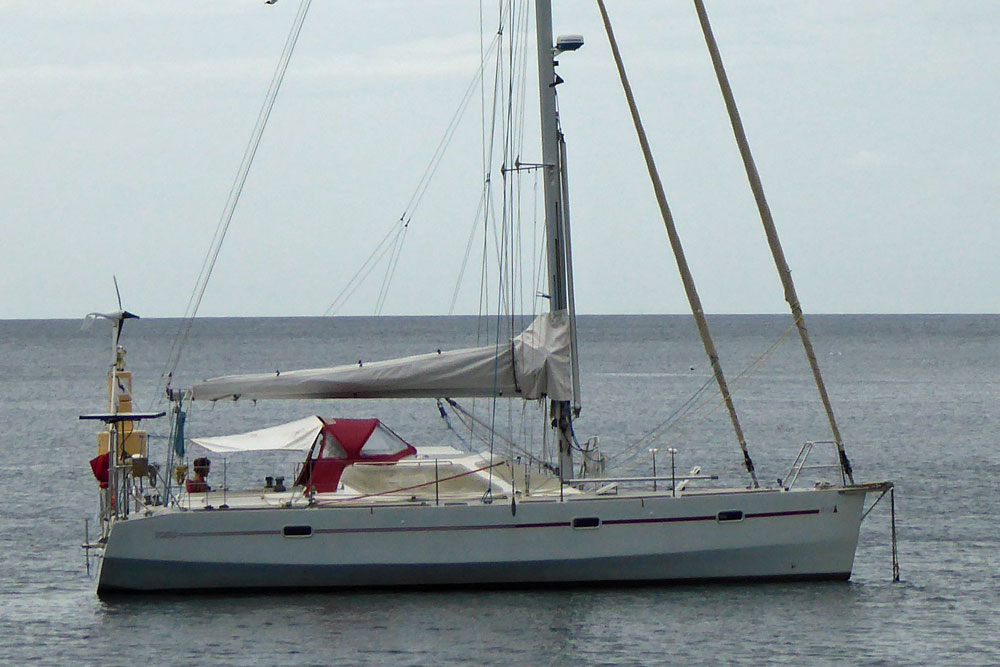 The RM1350 epitomised the fast, high-volume cruiser suitable for extended voyages.
The RM1350 epitomised the fast, high-volume cruiser suitable for extended voyages.Specs & performance indicators for the RM1350...
Interior Layout & Onboard Experience
What makes the interior of an RM suitable for long-term cruising & liveaboard life?
The interior of an RM is a revelation to anyone accustomed to older, dark, traditional yacht interiors. The design principle is often described as a 'loft effect', characterised by natural light, exceptional volume, and a dry, warm atmosphere.
The most celebrated feature is the panoramic saloon window, which offers a genuine 180-degree view from the dinette—a major safety and comfort advantage when keeping watch from below during foul weather or simply enjoying the anchorage.
- Practicality: Interiors are functional, with a focus on usability at sea. The galley is typically U-shaped and secure, and the chart table is often full-sized and forward-facing, a genuine working station rather than an afterthought. Ample stowage is designed for long-term cruising and liveaboard demands.
- Finish: The joinery is of a high standard, making extensive use of the exposed, epoxied plywood, which gives a warm, bright, and modern-yet-robust aesthetic. The construction material's natural insulation properties ensure a very dry interior environment, ideal for avoiding mildew and condensation on a liveaboard sailboat.
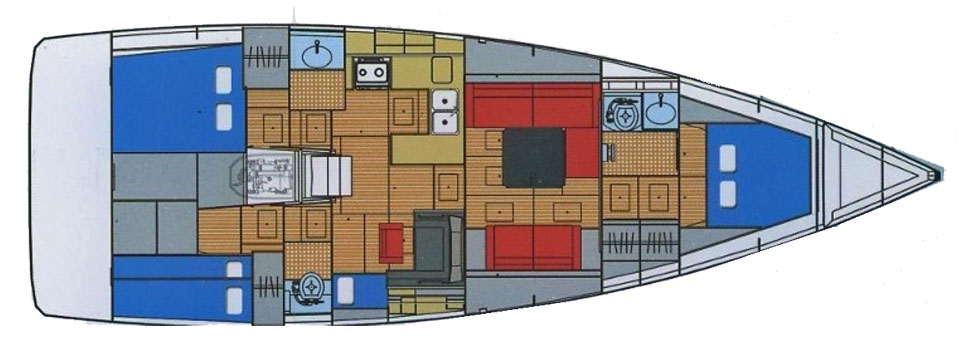
What to Look For: Buying Guide & Known Issues
As a potential owner, your background as an experienced sailor will help you appreciate the practicalities and potential quirks of the RM brand.
What challenges or maintenance factors should be considered when buying a used RM yacht?
While the plywood-epoxy construction provides immense strength and longevity, a buyer should focus their survey on a few key areas:
- Epoxy Integrity: The critical factor is the long-term integrity of the epoxy coating on the hull. While very durable, any breach of the epoxy over time could expose the underlying plywood to moisture. A thorough moisture meter survey of the hull is essential, though it should be noted that modern epoxy systems have proven exceptionally reliable.
- Keel & Rudder Attachments: Inspect the galvanised steel frame (where fitted) and the attachment points for the keel and twin rudders. Although the steel frame is sealed, its condition is paramount.
- Owner Customisation: RM encourages a degree of customisation, particularly with interior finish and system installation. While this is often a positive, inspect the quality of any non-factory-installed systems (electrical, plumbing) to ensure they meet your high offshore standards.
- Historical Context: Be aware of the brand's financial history (the 2019 receivership). Although the new GLY ownership has stabilised the company, older boats were built by the previous entity (Fora Marine), and a clear maintenance and ownership history is vital to ensure consistency of build quality.
On the Water...
As the owner of a wood-epoxy (but cedar strip rather than plywood) I know that the ability to self-repair a wood-epoxy hull with common materials—a skill easily learned—is a significant advantage for global cruising. Remarkably effective field repairs can be made that would be far more complex on a cored fibreglass structure.
The RM Brand: Market Position & Contribution
The RM brand occupies a specialist niche, positioned above the high-volume production builders but offering a more pragmatic, less extreme solution than pure racing-derived yachts. They are an attractive alternative for those who find aluminium yachts (like Allures or Garcia) too heavy, yet want more light, volume, and stiffness than a standard GRP (Glass Reinforced Plastic) production cruiser.
RM's greatest contribution to sailboat design is arguably the popularisation of the multi-chine hull and the raised-saloon style with panoramic visibility on a mainstream production cruiser. They helped prove that modern, innovative materials and bold aesthetics could translate into safe, comfortable, and genuinely high-performance cruising yachts.
Summary: A Unique & Enduring Option
RM yachts are a unique and compelling choice for the experienced ocean sailor. They represent a rare combination of Marc Lombard’s race-proven naval architecture, the structural benefits of plywood-epoxy composite construction, and a genuinely comfortable, light-filled interior built for the rigours of long-term cruising. They are fast, safe, and easily handled, making them ideal for a couple or single-handed sailor looking to make quick passages and arrive in comfort. For a sailor who values proven performance and a distinctive build quality, an RM warrants serious consideration.
This article was written by Dick McClary, RYA Yachtmaster and author of the RYA publications 'Offshore Sailing' and 'Fishing Afloat', member of The Yachting Journalists Association (YJA), and erstwhile member of the Ocean Cruising Club (OCC).
Frequently Asked Questions (FAQs)
What is the main benefit of the RM’s plywood-epoxy construction over fibreglass?
What is the main benefit of the RM’s plywood-epoxy construction over fibreglass?
The primary benefit is the superior strength-to-weight ratio and the resulting hull stiffness, which translates directly to better sailing performance. Additionally, the wooden core provides natural insulation, significantly reducing interior condensation and making the boat warmer and drier.
Are RM sailboats suitable for single-handed sailing or short-handed crews?
Are RM sailboats suitable for single-handed sailing or short-handed crews?
Yes, they are highly regarded for short-handed sailing. Their design, inspired by racing yachts, features sail plans and cockpit layouts that centralise control, making them manageable for a solo sailor or a couple. The high average speed also reduces overall passage time.
Is the twin keel option good for offshore cruising?
Is the twin keel option good for offshore cruising?
The twin keel option is an excellent choice for offshore cruising, particularly in tidal regions. While slightly less efficient upwind than a deep single keel, the twin keels provide high stability and allow the yacht to safely take the ground, opening up cruising areas unavailable to deep-draught vessels.
How does the RM 1260 compare to other 40-foot performance cruisers?
How does the RM 1260 compare to other 40-foot performance cruisers?
The RM 1260 stands out with its lighter displacement and the unique panoramic saloon. While competitors might offer a more traditional interior or a deeper ballast ratio, the 1260 offers faster off-wind performance and superior interior light and volume due to its construction and broad beam.
What is the average resale value of an RM yacht?
What is the average resale value of an RM yacht?
RM yachts generally hold their value well. Their niche market and unique construction attract knowledgeable buyers who appreciate the brand's specific benefits, meaning demand remains high for well-maintained examples.
Recent Articles
-
Hans Christian 43: Classic Bluewater Cruiser & Liveaboard Sailboat
Dec 10, 25 04:37 AM
Explore the Hans Christian 43: a legendary heavy-displacement, long-keel sailboat. Read our in-depth review of its specs, design ratios, and suitability for offshore cruising and living aboard. -
Planning Your Sailboat Liveaboard Lifestyle: An Ocean Sailor's Guide
Dec 06, 25 05:18 AM
Seasoned sailors share their methodical risk analysis for planning a secure Sailboat Liveaboard Lifestyle, covering financial, property, and relationship risks. -
Marine Cabin Heaters: The Expert’s Guide to Comfort & Safety at Sea
Dec 05, 25 06:52 AM
Choose the best Marine Cabin Heaters for your vessel. Expert advice on diesel, paraffin, and hot water systems for year-round cruising comfort.

